Abstract
Strategies to reduce US infant mortality rates often focus on the black-white disparity in rates. Linked Infant Birth and Death Files for Davidson County, Tennessee, from 1990 through 1994 were used to determine infant outcomes for infants born to college-educated white and black women. Risks for adverse outcomes were identified by comparing infant deaths to live births using logistic regression analyses. The following variables entered the logistic model process: maternal and paternal age; race and education; nativity status; maternal risk factors; interpregnancy interval; parity; infant gender; tobacco or alcohol use; number of prenatal visits; trimester in which prenatal care began; marital status; gestational age; and birthweight. After adjustment for the effects of the other variables, a gestational age < 28 completed weeks of gestation was the most significant independent predictor of infant death. Black race was not identified as a significant predictor of infant mortality. Regardless of race, a decrease in infant mortality rates among college-educated women in this country depends on the prevention of preterm births. Strategies to diagnose early preterm labor must proceed from a comprehensive maternal care program for all women. Open channels of communication between patient and provider will form the cornerstone for preterm prevention-intervention programs. Analysis of state and local infant mortality data may identify regional differences in infant mortality rates and differences in risk factors associated with adverse infant outcomes.
Full text
PDF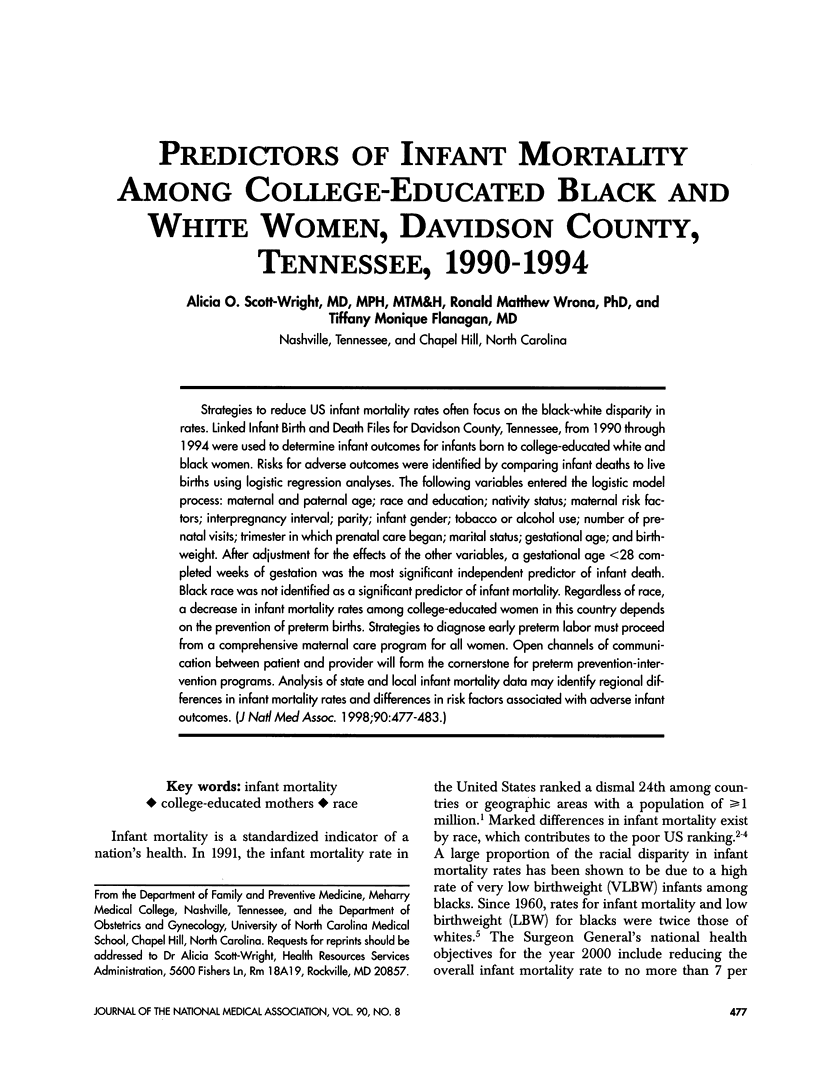
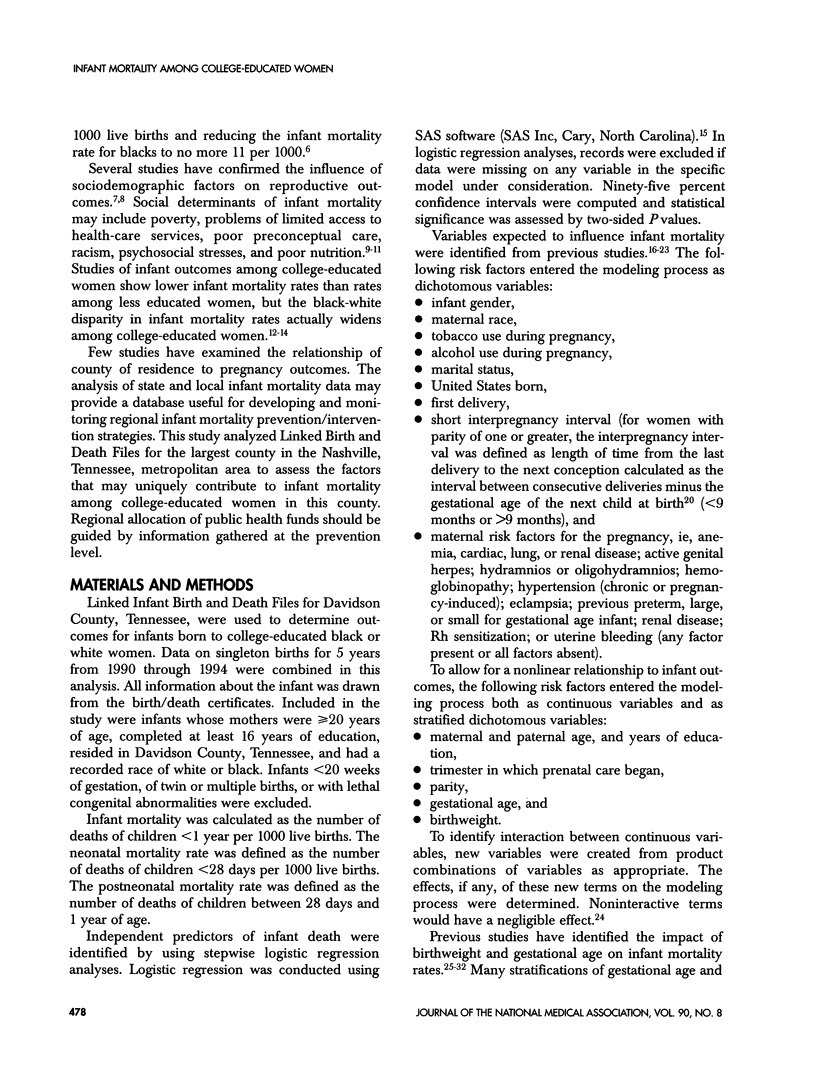
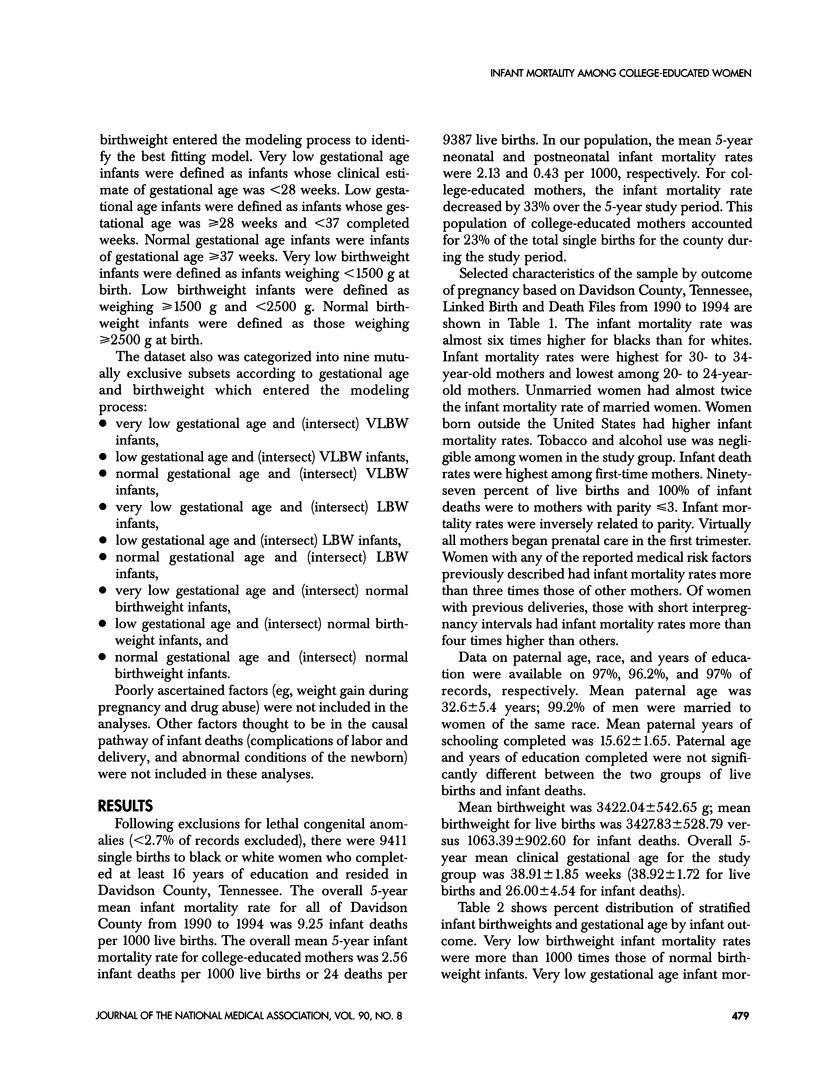
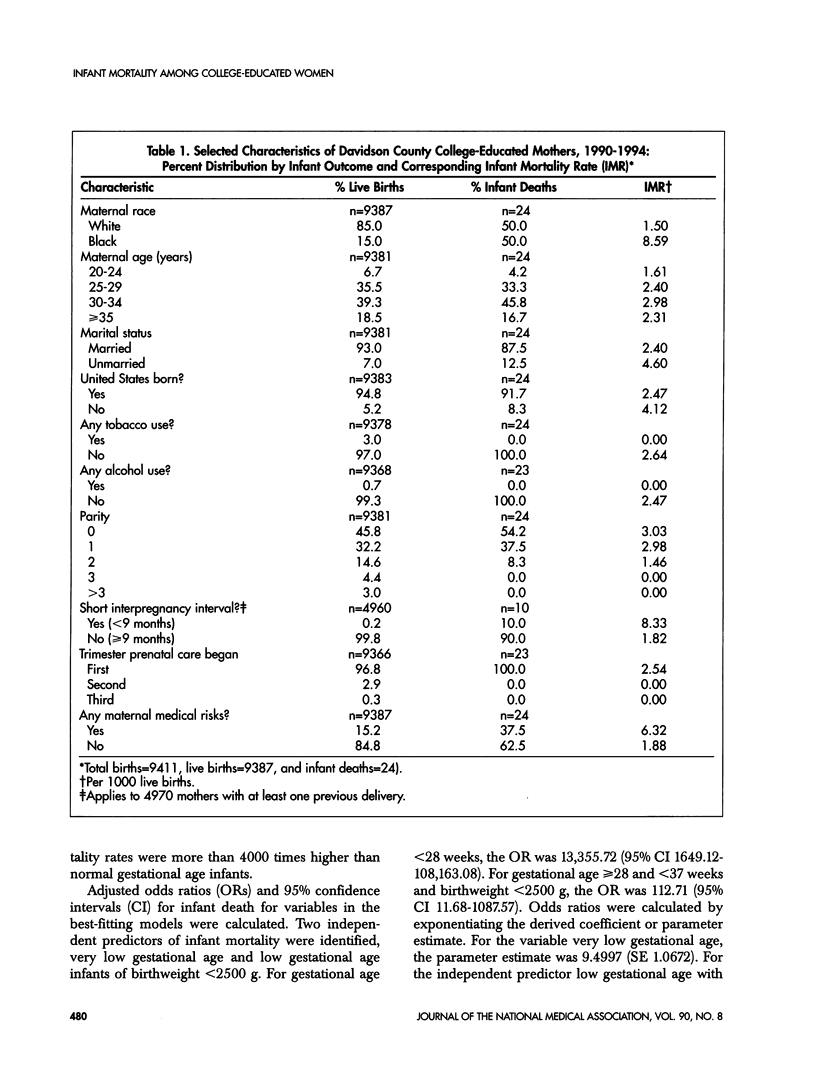
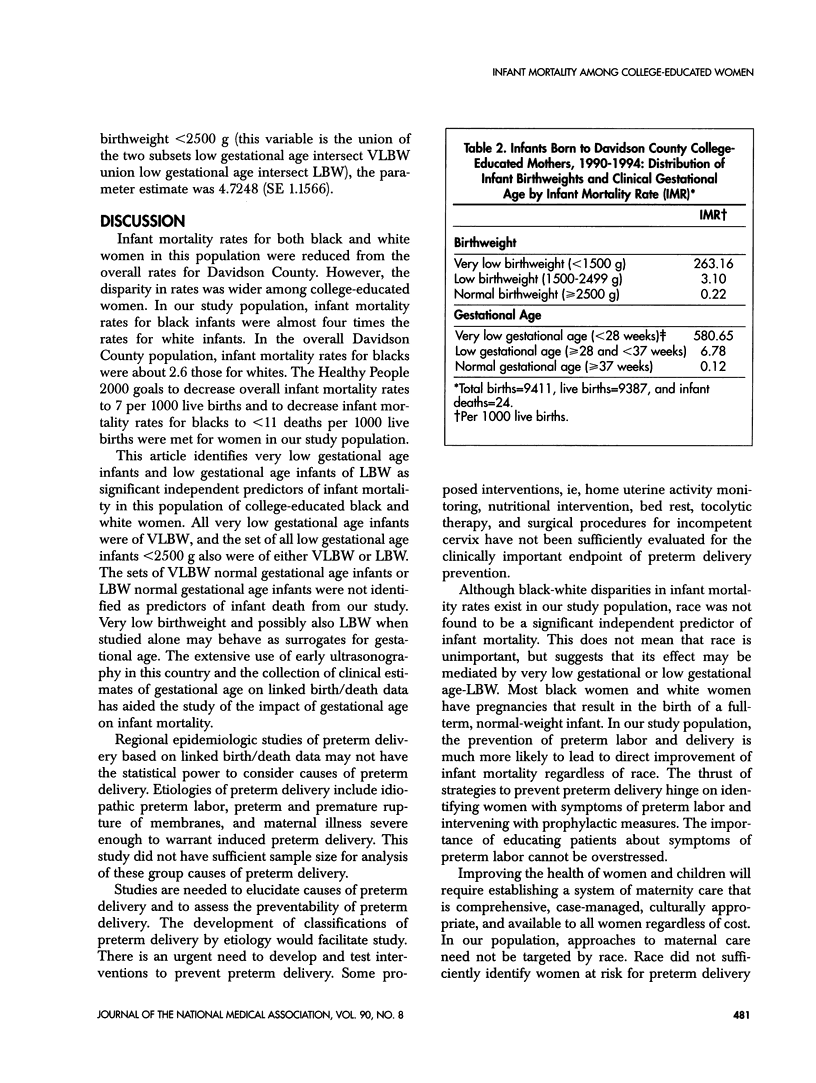
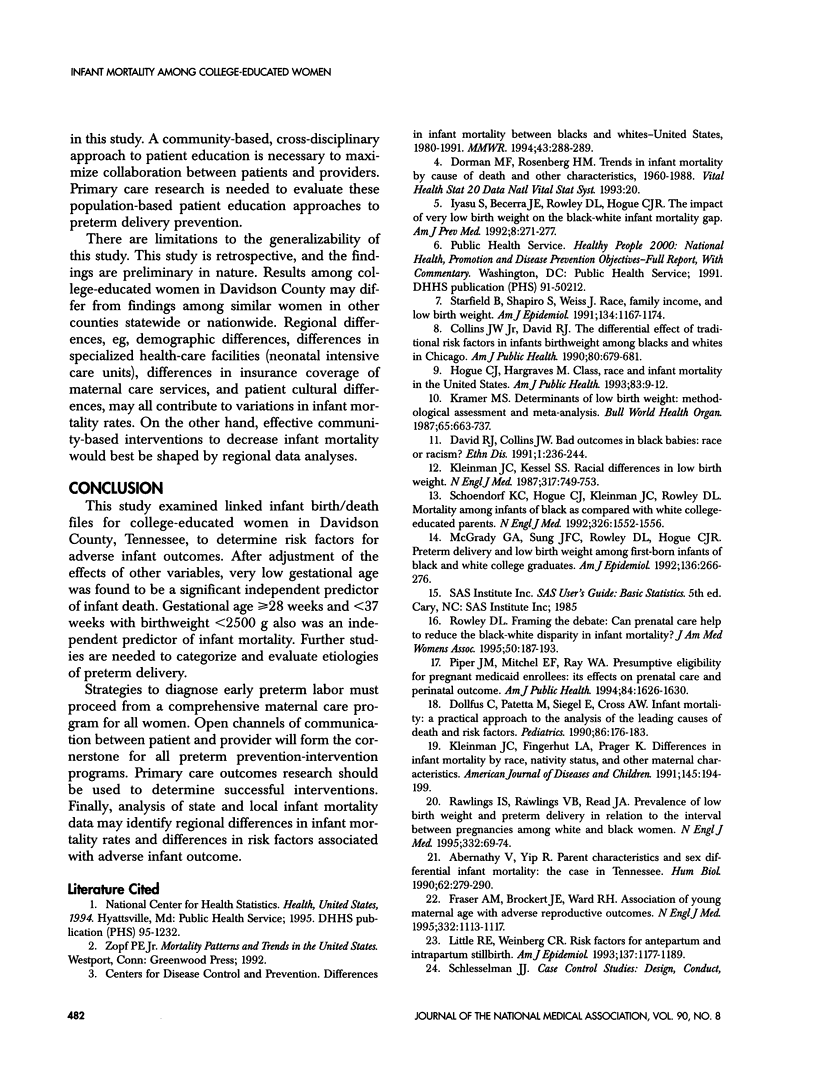

Selected References
These references are in PubMed. This may not be the complete list of references from this article.
- Abernethy V., Yip R. Parent characteristics and sex differential infant mortality: the case in Tennessee. Hum Biol. 1990 Apr;62(2):279–290. [PubMed] [Google Scholar]
- Centers for Disease Control and Prevention (CDC) Differences in infant mortality between blacks and whites--United States, 1980-1991. MMWR Morb Mortal Wkly Rep. 1994 Apr 29;43(16):288–289. [PubMed] [Google Scholar]
- Collins J. W., Jr, David R. J. The differential effect of traditional risk factors on infant birthweight among blacks and whites in Chicago. Am J Public Health. 1990 Jun;80(6):679–681. doi: 10.2105/ajph.80.6.679. [DOI] [PMC free article] [PubMed] [Google Scholar]
- Creasy R. K. Preterm birth prevention: where are we? Am J Obstet Gynecol. 1993 Apr;168(4):1223–1230. doi: 10.1016/0002-9378(93)90373-q. [DOI] [PubMed] [Google Scholar]
- David R. J., Collins J. W., Jr Bad outcomes in black babies: race or racism? Ethn Dis. 1991 Summer;1(3):236–244. [PubMed] [Google Scholar]
- Dollfus C., Patetta M., Siegel E., Cross A. W. Infant mortality: a practical approach to the analysis of the leading causes of death and risk factors. Pediatrics. 1990 Aug;86(2):176–183. [PubMed] [Google Scholar]
- Fraser A. M., Brockert J. E., Ward R. H. Association of young maternal age with adverse reproductive outcomes. N Engl J Med. 1995 Apr 27;332(17):1113–1117. doi: 10.1056/NEJM199504273321701. [DOI] [PubMed] [Google Scholar]
- Hogue C. J., Hargraves M. A. Class, race, and infant mortality in the United States. Am J Public Health. 1993 Jan;83(1):9–12. doi: 10.2105/ajph.83.1.9. [DOI] [PMC free article] [PubMed] [Google Scholar]
- Iyasu S., Becerra J. E., Rowley D. L., Hougue C. J. Impact of very low birthweight on the black-white infant mortality gap. Am J Prev Med. 1992 Sep-Oct;8(5):271–277. [PubMed] [Google Scholar]
- Kempe A., Wise P. H., Barkan S. E., Sappenfield W. M., Sachs B., Gortmaker S. L., Sobol A. M., First L. R., Pursley D., Rinehart H. Clinical determinants of the racial disparity in very low birth weight. N Engl J Med. 1992 Oct 1;327(14):969–973. doi: 10.1056/NEJM199210013271401. [DOI] [PubMed] [Google Scholar]
- Kleinman J. C., Fingerhut L. A., Prager K. Differences in infant mortality by race, nativity status, and other maternal characteristics. Am J Dis Child. 1991 Feb;145(2):194–199. doi: 10.1001/archpedi.1991.02160020086023. [DOI] [PubMed] [Google Scholar]
- Kleinman J. C., Kessel S. S. Racial differences in low birth weight. Trends and risk factors. N Engl J Med. 1987 Sep 17;317(12):749–753. doi: 10.1056/NEJM198709173171207. [DOI] [PubMed] [Google Scholar]
- Kramer M. S. Determinants of low birth weight: methodological assessment and meta-analysis. Bull World Health Organ. 1987;65(5):663–737. [PMC free article] [PubMed] [Google Scholar]
- Little R. E., Weinberg C. R. Risk factors for antepartum and intrapartum stillbirth. Am J Epidemiol. 1993 Jun 1;137(11):1177–1189. doi: 10.1093/oxfordjournals.aje.a116620. [DOI] [PubMed] [Google Scholar]
- McGrady G. A., Sung J. F., Rowley D. L., Hogue C. J. Preterm delivery and low birth weight among first-born infants of black and white college graduates. Am J Epidemiol. 1992 Aug 1;136(3):266–276. doi: 10.1093/oxfordjournals.aje.a116492. [DOI] [PubMed] [Google Scholar]
- Piper J. M., Mitchel E. F., Jr, Ray W. A. Presumptive eligibility for pregnant Medicaid enrollees: its effects on prenatal care and perinatal outcome. Am J Public Health. 1994 Oct;84(10):1626–1630. doi: 10.2105/ajph.84.10.1626. [DOI] [PMC free article] [PubMed] [Google Scholar]
- Rawlings J. S., Rawlings V. B., Read J. A. Prevalence of low birth weight and preterm delivery in relation to the interval between pregnancies among white and black women. N Engl J Med. 1995 Jan 12;332(2):69–74. doi: 10.1056/NEJM199501123320201. [DOI] [PubMed] [Google Scholar]
- Rowley D. L. Framing the debate: can prenatal care help to reduce the black-white disparity in infant mortality? J Am Med Womens Assoc. 1995 Sep-Oct;50(5):187–193. [PubMed] [Google Scholar]
- Rowley D. L. Research issues in the study of very low birthweight and preterm delivery among African-American women. J Natl Med Assoc. 1994 Oct;86(10):761–764. [PMC free article] [PubMed] [Google Scholar]
- Savitz D. A., Blackmore C. A., Thorp J. M. Epidemiologic characteristics of preterm delivery: etiologic heterogeneity. Am J Obstet Gynecol. 1991 Feb;164(2):467–471. doi: 10.1016/s0002-9378(11)80001-3. [DOI] [PubMed] [Google Scholar]
- Schieve L. A., Handler A. Preterm delivery and perinatal death among black and white infants in a Chicago-area perinatal registry. Obstet Gynecol. 1996 Sep;88(3):356–363. doi: 10.1016/0029-7844(96)00203-7. [DOI] [PubMed] [Google Scholar]
- Starfield B., Shapiro S., Weiss J., Liang K. Y., Ra K., Paige D., Wang X. B. Race, family income, and low birth weight. Am J Epidemiol. 1991 Nov 15;134(10):1167–1174. doi: 10.1093/oxfordjournals.aje.a116020. [DOI] [PubMed] [Google Scholar]
- Synnes A. R., Ling E. W., Whitfield M. F., Mackinnon M., Lopes L., Wong G., Effer S. B. Perinatal outcomes of a large cohort of extremely low gestational age infants (twenty-three to twenty-eight completed weeks of gestation). J Pediatr. 1994 Dec;125(6 Pt 1):952–960. doi: 10.1016/s0022-3476(05)82015-3. [DOI] [PubMed] [Google Scholar]
- Taeusch H. W., Supnet M. Gestational age, birthweight, and neonatal mortality for extremely premature inner-city African-American and Latino infants. J Natl Med Assoc. 1994 Apr;86(4):297–302. [PMC free article] [PubMed] [Google Scholar]
- Wilcox A., Skjaerven R., Buekens P., Kiely J. Birth weight and perinatal mortality. A comparison of the United States and Norway. JAMA. 1995 Mar 1;273(9):709–711. [PubMed] [Google Scholar]


